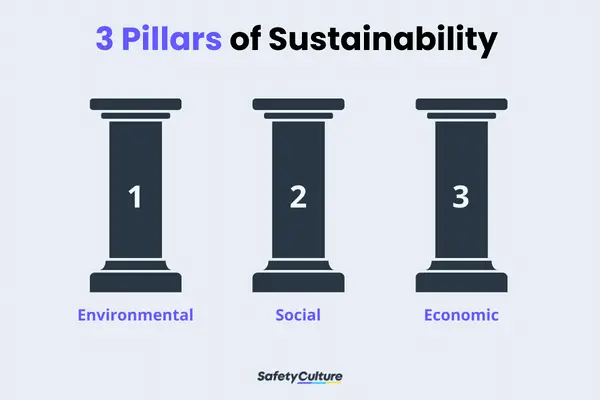What is Supply Chain Sustainability?
Supply chain sustainability refers to the process of managing supply chains in a way that is both economically and environmentally sustainable. It involves various approaches to ensure that businesses consume resources with minimal harm to the people and the environment—from sourcing raw materials to delivering products to customers. Sustainable supply chain practices allow companies to meet their current needs without compromising those of future generations.
Why is Supply Chain Sustainability Important?
Sustainable supply chains offer many advantages to organizations, not just for caring for the planet and those impacted by activities in the supply chain but also for empowering people and maximizing profit opportunities for stakeholders.
First, it allows businesses to minimize the impacts of their activities on the environment. With sustainable practices, they can decrease their carbon footprint, reduce waste, and conserve resources. These practices also empower them to devise efficient and cost-effective ways to carry out their operations while protecting the environment.
Supply chain sustainability is also crucial for building strong relationships with customers and suppliers. By taking steps to reduce their environmental footprint, businesses can demonstrate their commitment to social responsibility and ethical business practices. This, in turn, can build trust and loyalty among their vendors and clientele, leading to increased sales and improved customer satisfaction.
Lastly, a commitment to sustainable supply chain management helps improve a company’s brand image and reputation. Establishing itself as a socially responsible business can help a company stand out from its competitors and attract more customers.
Elements
A sustainable supply chain consists of the following 3 elements:

3 Pillars of Sustainability
Environmental
This component considers the ecological aspect of supply chain operations. These efforts are geared towards protecting the environment from potential hazards due to business activities by suppliers, vendors, and partners across the supply chain. They also involve compliance with environmental laws and regulations in the place where the business is operating.
Examples of environmental metrics to consider include:
- Energy and water use
- Waste management
- Emissions reduction
Social
The second element pertains to the business’ social responsibility to the people involved in and affected by its operations—its employees, customers, vendors, local communities, and so forth.
In its most basic sense, businesses must treat every person in the supply chain with dignity, respect, and fairness. This can be done by following labor laws and safety regulations, diversifying their supplier base, and uplifting communities in their place of business.
When measuring the social impact of your supply chain, here are a few things to consider:
- Labor standards
- Health and safety performance
- Diversity and inclusion in the workplace
- Supplier diversity
Economic
The economic element of supply chain sustainability refers to the financial requirements of the business. It involves creating safeguards to secure the business’ profits to serve its customers, shareholders, and partners—without compromising the environment and its people.
Listed below are a few examples of benchmarks for the supply chain’s economic performance:
- Cost savings
- Efficiency gains
- Customer satisfaction
Approaches
Supply chain sustainability encompasses a variety of techniques and approaches, such as:
- Green supply chain management – focuses on reducing the environmental impact of the supply chain through initiatives such as decreasing energy consumption, using renewable energy sources, and minimizing waste
- Sustainable sourcing – involves sourcing materials and products from suppliers that are committed to ethical and sustainable practices
- Circular supply chain – revolves around a closed-loop system of reusing, recycling, and repurposing materials instead of discarding them (e.g., reverse logistics)
How to Build a Sustainable Supply Chain
After learning the essential components and approaches in supply chain sustainability, how do you establish it in your business? Here are the 5 key steps to do this:
1. Determine Sustainability Issues in the Supply Chain.
First, it’s important to find areas of inefficiency or waste in the supply chain, such as high energy consumption levels and poor waste management. Start with a thorough assessment of the current supply chain operations and identify which parts need to be improved in terms of their environmental, social, and financial impacts.
To speed up this process, supply chain managers can use ready-made supply chain checklists. They can also reduce waste by switching from paper-based forms to digital ones, which they can fill out from their handheld device.
Create Your Own Supply Chain Checklist
Eliminate manual tasks and streamline your operations.
Get started for FREE2. Develop a Supply Chain Sustainability Program.
Once these inefficiencies have been identified and analyzed, the next step is to create a plan to address them. It should establish specific targets and objectives in line with the goals of the business. Moreover, it should map out the timeline for implementing the plan.
3. Strategize How to Carry Out the Plan.
Next, you need to outline the steps in implementing the plan. In this step, make sure to analyze in detail the current supply chain and the potential impacts of any changes. It includes carefully examining sustainable methods and considering their potential benefits and risks. Doing this allows you to find the right strategy that will work for your business.
4. Engage All Stakeholders.
Before carrying out the plan, it has to be communicated with your stakeholders first. Sharing your sustainability strategy with your suppliers and partners allows them to better understand the changes across the supply chain and clarify their role in it. This way, they can implement these sustainable practices successfully.
5. Monitor the Progress of Implementation.
Once the sustainability program is in motion, it’s a must to keep track of its progress over time. This can be done through key performance indicators (KPIs), such as:
- Environmental, social, and economic factors
- Customer feedback
- Employee engagement
- Supplier performance
Reviewing the strategy on a regular basis ensures that it’s achieving the goals and targets set out in the plan. Moreover, it allows you to adjust things as needed to ensure sustainable change in your supply chain.
Integrate ESG principles into your operations
Drive sustainable growth and create long-term value with our ESG solutions.
Explore nowChallenges
Applying sustainability practices to the supply chain has its fair share of challenges. The 3 most common of them are as follows:
Costs
One of the biggest challenges in creating a sustainable supply chain is the cost to implement it. Starting the program can require substantial investment in new tools, technology, processes, and personnel. These can pose a significant economic burden to companies, especially those already struggling financially.
Complexity of the Process
Introducing sustainable practices in the supply chain can seem complicated at first glance. From the planning to the implementation phase, businesses have various factors to consider, such as:
- Environmental impact of the supply chain operations
- Ethical practices of suppliers and partners
- Cost of enforcing sustainable practices
Aside from being a difficult and time-consuming process, it may also need additional resources (e.g., training) to ensure that employees and suppliers can properly manage the supply chain in a responsible manner.
Supplier Buy-In and Participation
Lastly, businesses could face resistance from their suppliers when attempting to establish a sustainable supply chain. Some may be reluctant to change their practices, while others may not have enough resources to invest in the necessary processes and tools for green practices.
For this reason, businesses must be ready to negotiate with their supplier base to ensure their conformance with sustainable practices. For example, they can provide incentives to encourage suppliers to adopt these changes in their operations.
FAQs about Supply Chain Sustainability
The 3 E’s of supply chain sustainability are as follows:
- Economy – using and managing resources throughout the supply chain
- Ecology – determining the impacts of business activities on other living beings and the environment
- Equity – anchoring decisions on and treating employees and stakeholders with dignity and respect
Businesses of all sizes—from small enterprises to large corporations—can carry out sustainable practices in their supply chain. These are especially helpful for companies that have a large number of suppliers, a global supply chain, and that heavily rely on natural resources.
Some of the sustainable initiatives and practices that companies have implemented in their supply chain include:
- Sustainably sourcing raw materials and products
- Switching to renewable energy sources (e.g., solar, wind, geothermal)
- Working with suppliers that are certified to the highest environmental standards
- Reusing waste or by-products from the supply chain
- Optimizing existing processes for water and energy efficiency
Small and mid-sized companies can create a greener supply chain by:
- Partnering with sustainable and ethical suppliers, manufacturers, and distributors
- Using eco-friendly packaging materials instead of plastic ones
- Replacing paper-based processes with digital solutions



